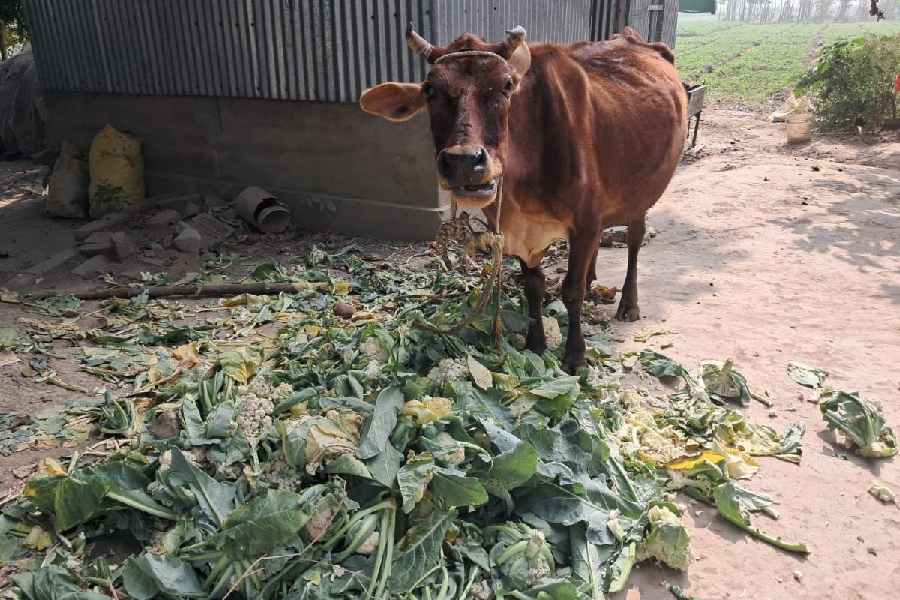A bumper cauliflower crop this winter has led hundreds of farmers in Kalna, East Burdwan, to feed their produce to cattle since the wholesale-market prices are insufficient to cover the vegetable’s transport costs.
“I grew cauliflowers on about two acres. With the price of a cauliflower dropping to ₹2, I fed a substantial part of my produce to my cattle rather than let it rot in the fields,” said Ranajit Das, a vegetable farmer from Doghori village in Purbasthali.
“Unlike potatoes, cauliflowers cannot be stored and sold later,” he explained.
Several other farmers too said they had decided not to sell their cauliflowers because the cost of hiring a mini-truck to ferry them to the wholesale markets would be higher than the selling price.
While the wholesale prices are abysmal, the retail price of a cauliflower in Calcutta is ₹15-20. In the districts, it’s around ₹10 per vegetable.
“This is because the middlemen buy it cheap and sell it at much higher prices. Still, the retail price of a cauliflower is reasonably low this year,” a senior state government official said. Last winter, a cauliflower sold at ₹25-28 in Calcutta.
What has compounded the farmers’ problems is that the cauliflower’s size has been bigger this year. Since the vegetable sells individually, this means the price per gram is even lower than appears at first sight. A second problem is the Bengali buyer’s traditional preference for smaller cauliflowers.
Bengal is the country’s largest producer of cauliflowers. Horticulture department sources said some 44,000 small farmers annually produce 16 lakh tonnes of the crop, across 55,000 hectares, inthe state.
Apart from East Burdwan, the major cauliflower-producing districts include North 24-Parganas, South 24-Parganas, Hooghly and Nadia.
While the horticulture department did not reveal the volume of the surplus crop this winter, a senior official said the overall production would be at least 20 per cent higher compared with the past few years.
Farmers said the average cost of producing a cauliflower was ₹6-7, and selling the crop for ₹2 or ₹3 amounted to distress sale. They also flagged the rise in fertiliser prices from ₹760 a bag to ₹1,300 over the past two years.
To harvest cauliflowers on one bigha of land, a farmer has to shell out ₹25,000-30,000, while the present wholesale market rate of ₹2-3 brings in only ₹10,000-12,000.
“This means a loss of ₹15,000 to ₹20,000 per bigha,” said Badal Chandra Das of Purbasthali. “How can we survive? I’ve been growing cauliflowers for 19 years, but I shall think twice before doing so next year.”
The farmers said they had spoken to their peers in neighbouring Nadia and North 24-Parganas and learnt that the crop’s production has been high and its prices lowthere too.
To try and provide relief, the state’s agriculture marketing department has begun buying cauliflowers directly from the farmers. It has for the first time opened 85 vegetable-purchasing centres across the state, and is also visiting the farms to makethe procurements.
“We are buying cauliflowers directly from the farms to avert distress sales and selling them through our Sufal Bangla stalls. We are providing 80 per cent of the retail price to the farmers (which is several times higher than what the middlemen pay them),” a senior official said.
“Every day, the agriculture marketing department buys 13 tonnes of vegetables, including cauliflowers and cabbages, both of which are witnessing very low market prices.”
Farmers said the government initiative was good but did not cover every farmer willing to sell theirproduce. Agriculture marketing department officials agreed that the government cannot afford to buy the entire cauliflower produce fromthe farmers.
Horticulture department officials flagged the problem of size. “The size (weight) of a cauliflower produced in Kalna this year is much higher than the usual average of 600-800 grams. But the demand (from consumers) is greater for the smaller varieties,” said Lidia Mochary, sub-divisional horticulture officerin Kalna.
“But the agriculture marketing department’s efforts are helping at least a section of the farmers.”











